Dell XPS 15z: Sincerely Flattering
by Jarred Walton on September 2, 2011 1:30 AM ESTDell XPS 15z Battery Life: Up to 7.5 Hours
It’s interesting to look at battery life for what should otherwise be similar laptops, as the results aren’t always what you’d expect. Consider NVIDIA’s Optimus Technology, which allows the discrete GPU to complete shut off when it’s not in use. Given that the dGPU isn’t using any power in such laptops, in theory we should see consistent relative battery life across all Sandy Bridge (or Second-Generation Core i-series if you prefer the official name) laptops—with dual-core offerings doing somewhat better than quad-core laptops. A look at the results in Mobile Bench however proves that this doesn’t always happen.
ASUS’ K53E uses an i5-2520M and manages 6.43 min/Wh in the Internet test, but the Toshiba M645 only gets 5.23 min/Wh. On the quad-core side of things, the initial Sandy Bridge test laptop got 5.86 min/Wh—a mark yet to be equaled by any shipping SNB quad-core laptops! Alienware’s M14x gets 5.02 min/Wh in the same test while the Dell XPS 15 L502x only scores 4.73 min/Wh (or 4.8 min/Wh with a larger 90Wh battery). There’s certainly variance among the laptops, more than we’d attribute to LCD size or other factors. The question then is where the XPS 15z places, and thankfully it does much better than the XPS 15.
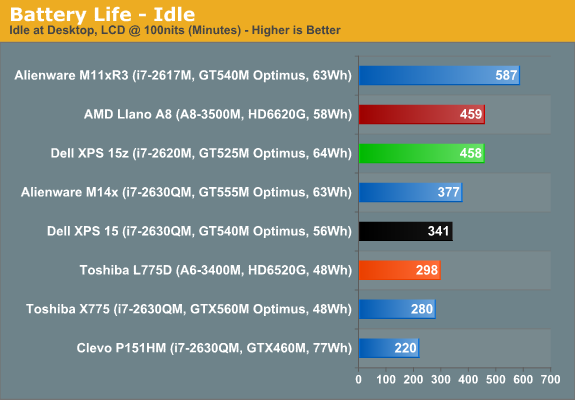
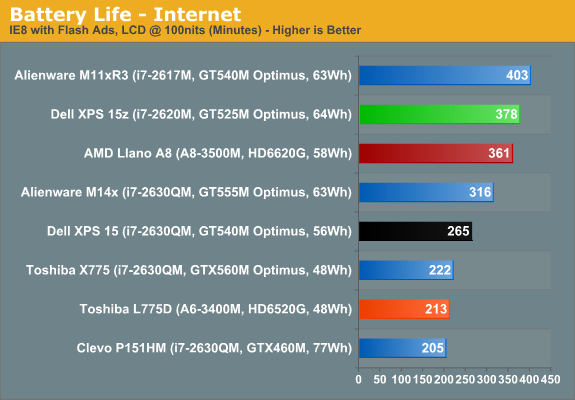
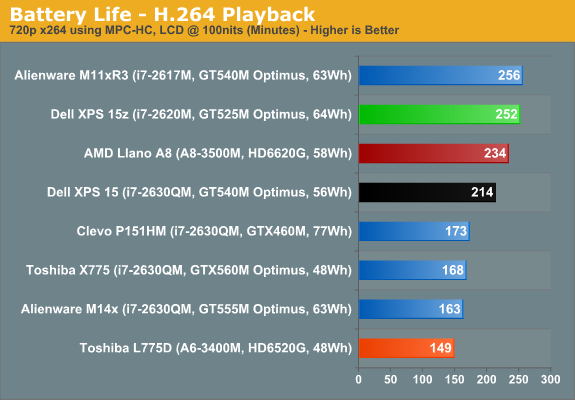
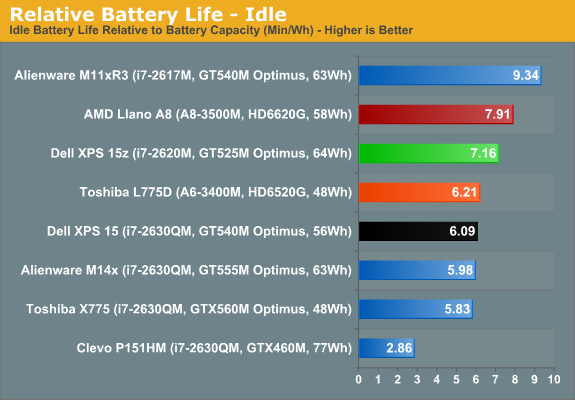
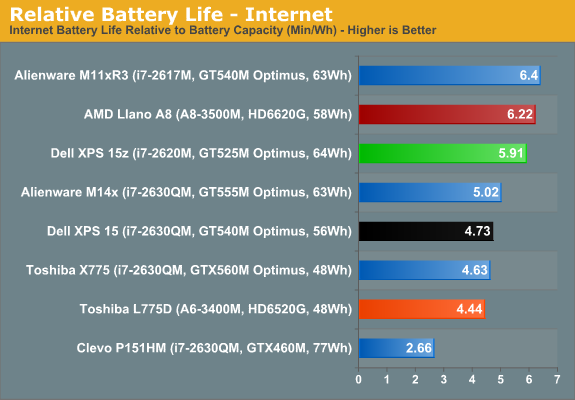

Dell’s XPS 15z not only beats the XPS 15, but it also leads most other Optimus enabled SNB laptops that we’ve tested. The ASUS K53E still wins out for dual-core SNB laptops (it’s not shown in the above charts, but you can see the comparison in Bench), but the only other SNB system to match/exceed the 15z is the Alienware M11x R3—a smaller laptop with a ULV processor. Idle battery life is over 7.5 hours, and if you want to drop the LCD below 100 nits (we tested at 33% brightness), you could probably hit eight hours. For more reasonable use cases, Internet browsing battery life is still an impressive 6+ hours, and H.264 playback from the HDD lasts over four hours.
In terms of modern laptops (e.g. excluding Atom netbooks and older CULV offerings), the only laptops that get better relative battery life than the XPS 15z are equipped with Brazos or Llano, or the already mentioned ASUS K53E and Alienware M11x R3. That puts the 15z in good company as far as operating off the mains is concerned. Of course, if we want to bring OS X into the picture, you’ll still have a hard time matching the 9+ hours the MBP13/15 can reach, but run Windows 7 on a MacBook and you’ll get substantially worse battery life. Unless you want/need more than six hours unplugged time, the XPS 15z should have you covered—at least until your battery starts wearing out and you have to pry open the chassis.










76 Comments
View All Comments
lukarak - Friday, September 2, 2011 - link
"In many ways the XPS 15z is a better laptop than the 15z,...." I might not be into Dell stuff, and there could be a Dell 15z as a separate model from XPS 15z, but i think you wanted to drop the Z the second time?Also, on topic, what's with the keyboard? If you copy the island design, don't mess with the shape of the keys, please.
JarredWalton - Friday, September 2, 2011 - link
Oops! Fixed, thanks. I actually call the MBP keyboard style "chiclet" and the Acer/Gateway stuff "floating island". Maybe others define "chiclet" differently? Anyway, typing on the 15z is actually quite nice, but like I mention I still prefer the XPS 15 keyboard layout.tbutler - Friday, September 2, 2011 - link
For those of us who remember the original 'chiclet' keyboards - the original PCjr, the TRS-80 CoCo, ZX Spectrum, etc. - the current keyboards aren't even CLOSE. :)The origin of 'chiclet' as a keyboard description was a derogatory term for those early keyboards - where the keys not only looked like chiclets, but were nearly impossible to touch-type on, because of both layout and the keyswitch design. Aside from the superficial look, the current keyboards have nothing in common; the layouts are 'normal', as are the keyswitches, and key travel is well within normal boundaries. Touch-typing is eminently possible, and in fact some of my favorite keyboards of the last couple of years have been in this style.
So yeah, I define 'chiclet' quite differently, and resist attempts to tar current keyboards with the same brush. :)
On another note: "The quality of the MBP15 display is better, but it’s hard to argue with a higher resolution and the 15z panel at least has a decent contrast ratio and brightness." On the contrary; I find it trivially easy to argue against a higher resolution. The 1440x900 MBP15 panel already causes me some eyestrain issues from the size of text and other interface elements, even at the admitted better display quality. The 1680x1050 panel was unlivable for extended use, and I can't even begin to describe the hurt a 15" 1080p display would cause me - especially if the overall display quality is lower.
iamezza - Friday, September 2, 2011 - link
this is what 'dpi' is forWindows 7 handles increasing the dpi very well, it can work with ALL programs. It can also be disabled on a per program basis if required.
Proph3T08 - Friday, September 2, 2011 - link
DPI is Dots per Inch usually when talking about monitors people use PPI (Pixels per Inch). A screen cannot change its PPI so anything Windows 7 would be doing would be software based to fake it.seapeople - Saturday, September 3, 2011 - link
You basically just agreed with him in a very strange way. DPI is how many pixels per inch the Windows interface renders certain UI elements such as window bars and text in. If you increase DPI, then Windows increases the resolution it uses to render text and other features, thereby making things bigger and easier to read without altering the actual pixel count being sent to your LCD screen, thereby preventing the blurriness you would otherwise get.neothe0ne - Friday, September 2, 2011 - link
"Dell gives you a GT 525M, which should be at least comparable to the HD 6750M in performance"I'm sorry but this can't possibly be true. The Radeon HD 5650M is a faster card than the GeForce GT 525M. How the hell could the GT 525M hope to compete with the 6750M?
Dustin Sklavos - Friday, September 2, 2011 - link
Agreed, the 6750M is more on par with the GT 540M if anything.Dustin Sklavos - Friday, September 2, 2011 - link
Actually, I'm incorrect. But either way, OP's point stands.I'm honestly really not impressed by the XPS 15z. 95C on the CPU cores is inexcusable, that keyboard sucks out loud, and the 1080p screen is among the worst we've tested in that class.
Also, anyone who deliberately spends up on the 2GB GT 525M upgrade deserves what they get. ;)
vol7ron - Friday, September 2, 2011 - link
I got my first Apple, which happened to be the 15" Macbook Pro. Worth the price? Not really. Apple OS freezes more than anything. It's only got a 2.0GHz QC, but I put a OWC SSD, 8GB of RAM, and upgraded to the anti-glare HD screen.So why do I like it? For the OS? no. For the keyboard? definitely no. For the trackpad gestures? kind of. For the quality screen? most definitely. The experience difference is in the screen alone. Viewing www.steampowered.com's opening page is an oddly different experience than viewing it on my desktop (better graphics card and more expensive monitors) and that's just for a static page. HD videos make it better too. I just wish it had better speakers - oh well.
XPS doesn't look bad, but the screen is where the user can really have that overwhelming sensation.